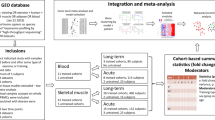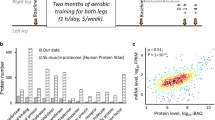Abstract
The results obtained in recent years on the numerous functions of the MYC protein convincingly indicate that MYC overexpression induced by physical activity (PA) occurs at the transcriptional and epigenetic levels with the participation of low molecular weight metabolites formed during the enhancement of intermediate metabolism. The current hypothesis proposes that the MYC network of transcription factors may account substantially for the exercise-induced adaptive changes in muscle and other vital organs through changes in lactate dynamics. This review presents the MYC transcription factor network that is involved in cell cycle regulation, growth, proliferation, and cell metabolism.





Similar content being viewed by others
REFERENCES
Carroll, P.A., Freie, B.W., Mathsearaja, H., and Eisenman, R.N., The MYC transcription factor network: balancing metabolism, proliferation, and oncogenesis, Front. Med., 2018, vol. 12, no. 4, p. 412.
Conacci-Sorrell, M., McFerrin, L., and Eiesen-man, R.N., An overview of MYC and its interactome, Cold Spring Harb. Perspect., 2014, vol. 4, no. 1, p. a014357.
Thomas, L.R., Wang, Q., Grieb, B.C., et al., Interaction with WDR5 promotes target gene recognition and tumorigenesis by MYC, Mol. Cell, 2015, vol. 58, no. 3, p. 440.
Kotekar, A., Singh, A.K., and Devaiah, B.N., BRD4 and MYC: power couple in transcription and disease, FEBS J., 2022. https://doi.org/10.1111/febs.16580
Devaiah, B.N., Mu, J., Akman, B., et al., MYC protein stability is negatively regulated by BRD4, Proc. Natl. Acad. Sci. U.S.A., 2020, vol. 117, no. 24, p. 13457.
Imran, A., Moyer, B.S., Kalina, D., et al., Convergent alterations of protein hub produce divergent effects within a binding site, ACS Chem. Biol., 2022, vol. 17, no. 6, p. 1586.
Farrell, A.S. and Sears, R.S., MYC degradation, Cold Spring Harb. Perspect., 2014, vol. 4, no. 3, p. a014365.
Chen, Y., Sun, X.X., Sears, R.C., and Dai, M.S., Writing and erasing MYC ubiquitination and SUMOylation, Genes Dis., 2019, vol. 6, no. 4, p. 359.
Das, S.K., Lewis, B.A., and Levens, D., MYC: a complex problem, Trends Cell. Biol., 2022, vol. 33, no. 3, p. 235.
Greib, B.C. and Eischen, C.M., MTBP and MYC: a dynamic duo in proliferation, cancer, and aging, Biology (Basel). 2022, vol. 11, no. 6, p. 881.
Endres, T., Solvie, D., Heidelberger, J.B., et al., Ubiquitylation of MYC couples transcription elongation with double-strand break repair at active promoters, Mol. Cell, 2021, vol. 81, no. 4, p. 830.
Das, S.K., Kuzin, V., Cameron, D.P., et al., MYC assembles and stimulates topoisomerases 1 and 2 in a topoisome, Mol. Cell, 2022, vol. 82, no. 1, p. 140.
Nie, Z., Guo, C., Das, S.K., et al., Dissecting transcriptional amplification by MYC, eLife, 2020, vol. 9. e52483
Patange, S., Ball, D.A., Wan, Y., et al., MYC amplifies gene expression through global changes in transcription factor dynamics, Cell Rep., 2022, vol. 38, no. 4, p. 110292.
Luo, W., Chen, J., Li, L., et al., c-MYC inhibits myoblast differentiation and promotes myoblast proliferation and muscle fiber hypertrophy by regulating the expression of its target genes, miRNAs and lincRNAs, Cell Death Differ., 2019, vol. 26, no. 3, p. 426.
Gohil, K. and Brooks, G.A., Exercise tames the wild side of the MYC network: a hypothesis, Am. J. Physiol.: Endocrinol. Metab., 2012, vol. 303, no. 1, p. E18.
Jolma, A., Yin, Y., Nitta, K.R., et al., DNA-dependent formation of transcription factor pairs alters their binding specificity, Nature, 2015, vol. 527, no. 7578, p. 384.
Morgunova, E. and Taipale, J., Structural perspective of cooperative transcription factor binding, Curr. Open Struct. Biol., 2017, vol. 47, p. 1.
Brooks, G.A., Arevalo, J.A., Osmond, A.D., et al., Lactate in contemporary biology: a phoenix risen, J. Physiol., 2022, vol. 600, no. 5, p. 1229.
Brooks, G.A., Curl, C.C., Leija, R.G., et al., Tracing the lactate shuttle to the mitochondrial reticulum, Exp. Mol. Med., 2022, vol. 54, no. 9, p. 1332.
Xue, X., Liu, B., Hu, J., et al., The potential mechanisms of lactate in mediating exercise-enhanced cognitive function: a dual role as an energy supply substrate and a signaling molecule, Nutr. Metab. (London), 2022, vol. 19, no. 1, p. 52.
Von Walden, F., Rea, M., Mobley, C.B., et al., The myonuclear, DNA methylome in response to an acute hypertrophic stimulus, Epigenetics, 2020, vol. 15, no. 11, p. 1151.
Mori, T., Ato, S., Knudsen, J.R., et al., c-MYC overexpression increases ribosome biogenesis and protein synthesis independent of mTORC1 activation in mouse skeletal muscle, Am. J. Physiol.: Endocrinol. Metab., 2021, vol. 321, no. 4, p. E551.
Murach, K.A., Liu, Z., Jude, B., et al., Multi-transcriptome analysis following an acute skeletal muscle growth stimulus yields tools for discerning global and MYC regulatory networks, J. Biol. Chem., 2022, vol. 298, no. 11, p. 102515.
Author information
Authors and Affiliations
Corresponding author
Ethics declarations
CONFLICT OF INTEREST
The authors declare the absence of obvious and potential conflicts of interest related to the publication of this article.
CONTRIBUTION OF AUTHORS TO THE PUBLICATION
I.V. Astratenkova, V.A. Rogozkin—collection and analysis of literary sources, N.D. Golberg—editing and technical design of the manuscript.
Rights and permissions
About this article
Cite this article
Astratenkova, I.V., Golberg, N.D. & Rogozkin, V.A. Regulation of Gene Expression by the MYC Transcription Factor Network During Exercise. Hum Physiol 49, 444–452 (2023). https://doi.org/10.1134/S036211972360011X
Received:
Revised:
Accepted:
Published:
Issue Date:
DOI: https://doi.org/10.1134/S036211972360011X




